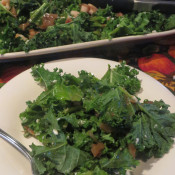Cheesesteak Egg Rolls

Being born and raised in South Philly, it was only a matter of time before I put together a dish inspired by our flagship sandwich, the coveted South Philly Cheesesteak. My in-law’s annual New Year’s Eve party was the perfect opportunity to do so. While there is never a shortage of good food at our family parties, I wanted to contribute something special and unique to help ring in the new year. I came up with a tasty South Philly-inspired appetizer …a cheesesteak egg roll.
Although the idea of a cheesesteak egg roll is not completely original (you can occasionally find them on restaurant menus), my recipe was totally off the cuff, inspired by the traditional tastes and ingredients of a true South Philly Cheesesteak. Just four basic ingredients – steak, provolone cheese, onions and egg roll wrappers – were the perfect combination. To help bring a sweeter, robust taste to the cheesesteak, I used caramelized onions in place of the traditional fried onions. You need a good 45 minutes to an hour to caramelize onions, so you’ll want to do this step a day or so in advance. I also used shredded provolone cheese in place of traditional sliced cheese (or, cheese whiz for some hard-core cheesesteak fans), and folded it along with the caramelized onions into the cooked steak, so that you get the full taste and flavor in every bite. I also baked the egg rolls instead of the traditional frying method. The steak, cheese and onion combination will create enough of their own oils within the egg roll, so there is no need to fry them in additional oil.
I’m very happy to say that the egg rolls were a big hit with everyone, and I’ve even gotten requests for a buffalo chicken cheesesteak version for my brother-in-law’s birthday. You can look for that follow-up post in another month or so. In the meantime, be sure to give my cheesesteak egg rolls a try. They’re an easy, delicious and filling snack food…perfect for your upcoming game day parties!
Ingredients:
(makes 20 egg rolls)
1.5 lbs thinly sliced rib eye or top round steak (if you cannot make it to your butcher shop, frozen steak sandwich meat such as Steak-umm will work)
4-5 onions, caramelized. You’ll want to do this a day or so ahead of time. Recipe below.
2 cups shredded provolone cheese
1 pack of egg roll wrappers (found in the produce section of your super market)
Salt and pepper
Olive oil
Directions:
Heat a skillet over medium heat. Add the steak to the pan, a few slices at a time. Add a little bit of water to the pan while cooking the steak. You want to make sure that the steak does not dry out while cooking. Just as the steak starts to brown, chop it in the pan and season with a bit of salt and pepper. Chop and flip the steak until fully browned, then remove and set aside. When the steak is cooled a bit, mix well with the onions and shredded cheese. You don’t want to add the steak mixture to the wrappers when the mixture is hot. It will soften up the wrappers and make it difficult to assemble.
*NOTE – full assembly instructions are included with the wrappers. You can also follow the step-by-step photos below.
Pre-heat oven to 400˚. Place an egg roll wrapper on a clean, flat surface, endpoints at the top and bottom (diamond shaped). Add one tablespoon of the steak mixture to the middle of the wrapper. Fold the bottom portion of the wrapper over the meat filing, then fold the left and right sides over, then gently roll it 3/4 of the way. Moisten the top corner of the wrapper with a bit of water (as if you were sealing an envelope), then fold it and seal it. Repeat steps with remaining wrappers.
Spray a baking sheet with non-stick cooking spray. Place the egg rolls seam-side down onto the sheet. Lightly brush the top of the egg rolls with olive oil. Bake for 10-12 minutes.
Serve immediately and enjoy.
You can also bake these ahead of time, and warm them up again for about 5-7 minutes.

The basic steps on how to fold an egg roll wrapper.
CARAMELIZED ONIONS
(courtesy of SimplyRecipes.com)
Ingredients:
Several medium or large onions, yellow, white, or red
Olive oil
Butter (optional)
Salt
Sugar (optional)
Balsamic vinegar (optional)
Slice off the stem ends of the onions and place them cut side down on the cutting board. Cut them in half through the root end. Peel the onions. Lay them cut side down and make angled cuts into each onion, aimed at the center, cutting almost all the way, but not completely through the root end. Make the cuts to your desired level of thickness. The root end will help hold the onion together as you cut it, making it easier to cut. Then cut a V in the root end to cut out the tough root holding the slices together.
Use a wide, thick-bottomed sauté pan for maximum pan contact with the onions. Coat the bottom of the pan with olive oil, or a mixture of olive oil and butter (about 1 teaspoon per onion). Heat the pan on medium high heat until the oil is shimmering. Add the onion slices and stir to coat the onions with the oil. Spread the onions out evenly over the pan and let cook, stirring occasionally. Depending on how strong your stovetop burner is you may need to reduce the heat to medium or medium low to prevent the onions from burning or drying out. After 10 minutes, sprinkle some salt over the onions, and if you want, you can add some sugar to help with the caramelization process. (I add only about a teaspoon of sugar for 5 onions, you can add more.) One trick, by the way, to keeping the onions from drying out as they cook is to add a little water to the pan.
Let cook for 30 minutes to an hour more, stirring every few minutes. As soon as the onions start sticking to the pan, let them stick a little and brown, but then stir them before they burn. The trick is to let them alone enough to brown (if you stir them too often, they won’t brown), but not so long so that they burn. After the first 20 to 30 minutes you may want to lower the stove temperature a little, and add a little more oil, if you find the onions are verging on burning. A metal spatula will help you scrape up the browned bits from the bottom of the pan as the caramelization proceeds. As the onions cook down, you may find you need to scrape the pan every minute, instead of every few minutes. Continue to cook and scrape, cook and scrape, until the onions are a rich, browned color. At the end of the cooking process you might want to add a little balsamic vinegar or wine to help deglaze the pan and bring some additional flavor to the onions.
Store refrigerated for several days in an air-tight container.





Recent Comments